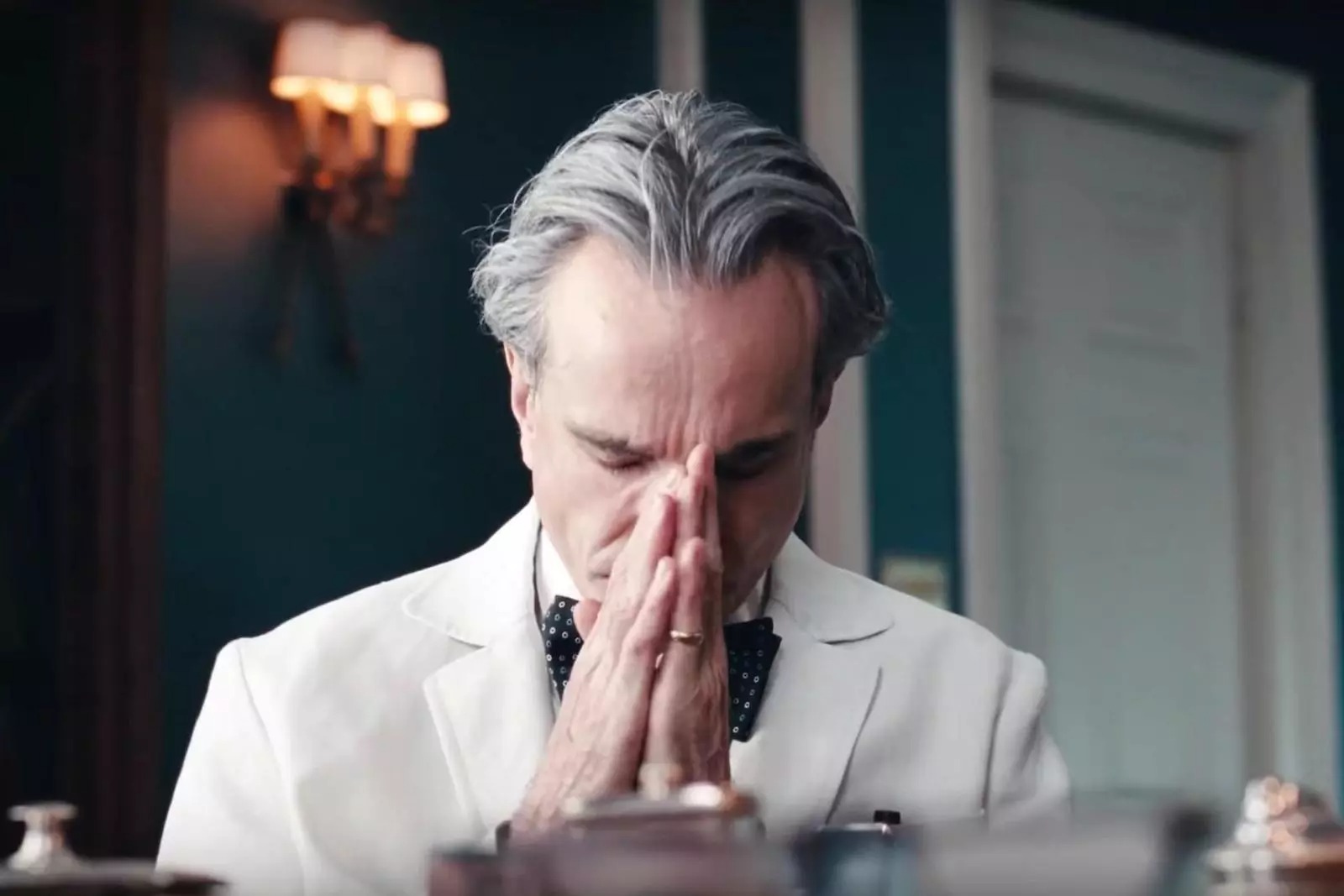A surprising conclusion defines the controversial love story. With his eighth feature, Paul Thomas Anderson presents another sophisticated period drama that breathes life into complex characters, who embody not simply good or evil but a spectrum of deep flaws.
Set in the 1950s, the film chronicles the life of Reynolds Woodcock, a renowned dressmaker who discovers Alma, the muse he has always longed for.
As their romantic involvement flourishes, they complement each other in their professional lives, yet Reynolds’s inflexible nature clashes with Alma’s affectionate yet possessive love, leading to a struggle between their obsessions. The Phantom Thread ending illuminates how this couple manages to coexist.

Every Paul Thomas Anderson film is an event in its own right. This particular movie marked the farewell of the legendary Daniel Day-Lewis, who delivered a memorable performance alongside Vicky Krieps, showcasing an onscreen chemistry that stands out as one of the most remarkable cinematic achievements of the 2010s.
Phantom Thread garnered six Academy Award nominations and achieved a 91% critic rating on Rotten Tomatoes, despite its contentious portrayal of a toxic relationship.
What Happens In The Phantom Thread Ending
To effectively explain the Phantom Thread ending, it’s crucial to revisit the moment Reynolds first falls ill. This episode follows a heated argument with Alma, during which he prioritizes his creative process over her desire for quality time together. Unlike previous partners, Alma refuses to be brushed aside, and her response is to poison him.
This violent illness nearly proves fatal for Reynolds, but he is nursed back to health with Alma’s support, allowing him to fall in love with her anew.
However, as time passes, Reynolds gradually reverts to his self-centered behavior and becomes weary of what he perceives as Alma’s intrusiveness. Contemplating a departure, he finds Alma resorting to the same method as before: preparing poisonous mushrooms right before him, which he willingly consumes.
Why Does Alma Poison Reynolds?
While Reynolds appears to be the central figure of the story, the Phantom Thread ending clarifies that the story is largely viewed through Alma’s lens. She serves as the essential thread that allows Reynolds to stitch together both his life and his work.
Alma brings a calming presence to Reynolds’s restless nature; she embodies a pause that provides relief to his incessant thoughts, although he would never acknowledge this. Yet, Alma comprehends him deeply, rendering her both a dangerous and nurturing force.
Breaking free from the stereotype of the “ideal wife” typical of the 1950s, Alma defies convention. She prepares meticulous meals for Reynolds, adheres to his demands, and works for him—albeit within certain limits. She also knows how to incite jealousy in him, enjoying her independence, which helps to assert her influence over their relationship.
Following an argument where Reynolds decries the lovely dinner she prepared, insisting that she disrupts his carefully structured routine, Alma decides to poison him with mushrooms, forcing him out of his established pattern. As a result, he becomes bedridden, delirious, and most importantly, amenable.
Upon recovering, Reynolds is enveloped in a warm affection for Alma, prompting him to propose marriage. This incident leads Alma to realize that their relationship can thrive only through these cycles of sickness and health, echoing the vows they would take at the altar.
Interestingly, Anderson drew inspiration for Phantom Thread from his wife, Maya Rudolph, and her nurturing nature toward him. By poisoning Reynolds, Alma asserts her power in their dynamic and revives his love through maternal care.
Did Reynolds Know He Was Being Poisoned?
The Phantom Thread ending clarifies that, during the second poisoning, Reynolds is aware of the poisoning yet willingly embraces it. A tense suspense envelops the final breakfast scene, where Reynolds observes Alma preparing a poisoned omelet.
The score and sharp editing signal an approaching climax, with the potential for dramatic revelation should Reynolds discover the truth. His unexpected reaction comes when he consumes the omelet contentedly, accepting both his illness and Alma’s intentions.
Hidden details within Paul Thomas Anderson’s storytelling reveal insights about Reynolds’s past and obsessions, especially through the secret messages he stitches into the linings of his dresses.
It’s fortunate that Reynolds remains among the living, as the story’s conclusion offers profound importance; he represents a self-contained individual so fixated on routine that he imposes his methods on everyone around him. The trauma of losing his mother profoundly impacted him, and only Cyril and Alma can perceive his true self.
His compulsive habits and dominating personality mask a deeper longing for care. This desire explains why he tolerates Alma’s poisonings; the illness serves as a reminder of his deceased mother while compelling him to drop his façade.
The nurturing side he displays after such episodes may not reflect his authentic self, but rather the person he aspires to be for those he loves, leading him to accept and even desire his affliction.
Do Reynolds & Alma Have A Happy Ending?
The Phantom Thread ending sheds light on the intricacies of the couple’s future interactions. “Kiss me, my girl, before I’m sick,” Reynolds implores, signifying a fragile truce in their tumultuous relationship with Alma. By the film’s conclusion, both characters appear to have reached an understanding, envisioning a harmonious path ahead.
It becomes apparent that Alma has been in communication with Dr. Robert Hardy all along, and she can vividly imagine herself and Reynolds dancing and embracing on the upcoming New Year’s Eve, contrasting starkly with their previous tumult.
While Reynolds and Alma likely continue their tumultuous cycle together, it is impossible to ignore the toxicity of their bond. The complexity of their relationship lies in the duality of their love; despite its flaws, it is both toxic and authentic, revealing an unexpected perfection.
Each person loves in a unique manner, and this dynamic can be inherently selfish: Reynolds and Alma seek validation from one another. By finally recognizing this aspect of their relationship, they seem liberated from external judgment, with Cyril acting as a watchful mediator.
The Meaning Of Phantom Thread’s Title
Deciphering the title Phantom Thread isn’t straightforward, but it becomes clearer when juxtaposed with a term commonly used by seamstresses in Victorian London’s East End.

“Phantom thread” describes the sensation experienced when returning home after long hours of sewing and finding oneself unconsciously stitching invisible threads in the air.
This term resonates perfectly with Reynolds’s persistent restlessness, making him akin to a “phantom thread.” Phantom Thread offers numerous hidden details, and its title enhances the viewer’s experience.
The secret messages stitched into Reynolds’s dresses seem to reflect his struggle with ceaseless sewing until Alma intervenes, liberating him from his internal strife.
The True Meaning Of Phantom Thread’s Ending
The film Phantom Thread explicitly connects to Sigmund Freud’s Oedipus complex theory and delves into various insightful psychoanalytic themes.
It serves as a compelling illustration of how individuals often project their identities onto those they love, demonstrating that there is no singular correct way to express love.
Although Reynolds and Alma’s relationship is hardly a model of healthy interaction, they acknowledge the sacrifices their love demands. By accepting their painful cyclical existence, they discover harmony and richness in their connection, functioning as each other’s muses in both personal and professional spheres.



